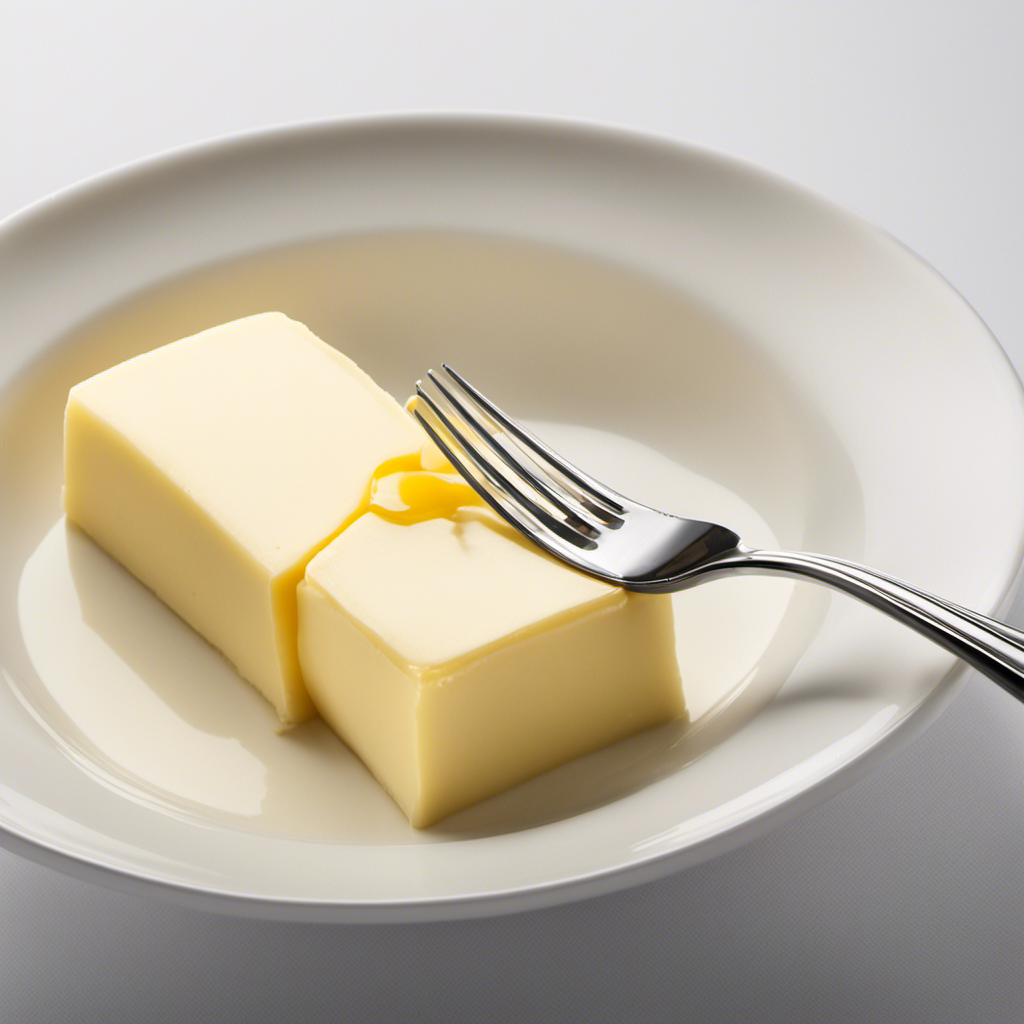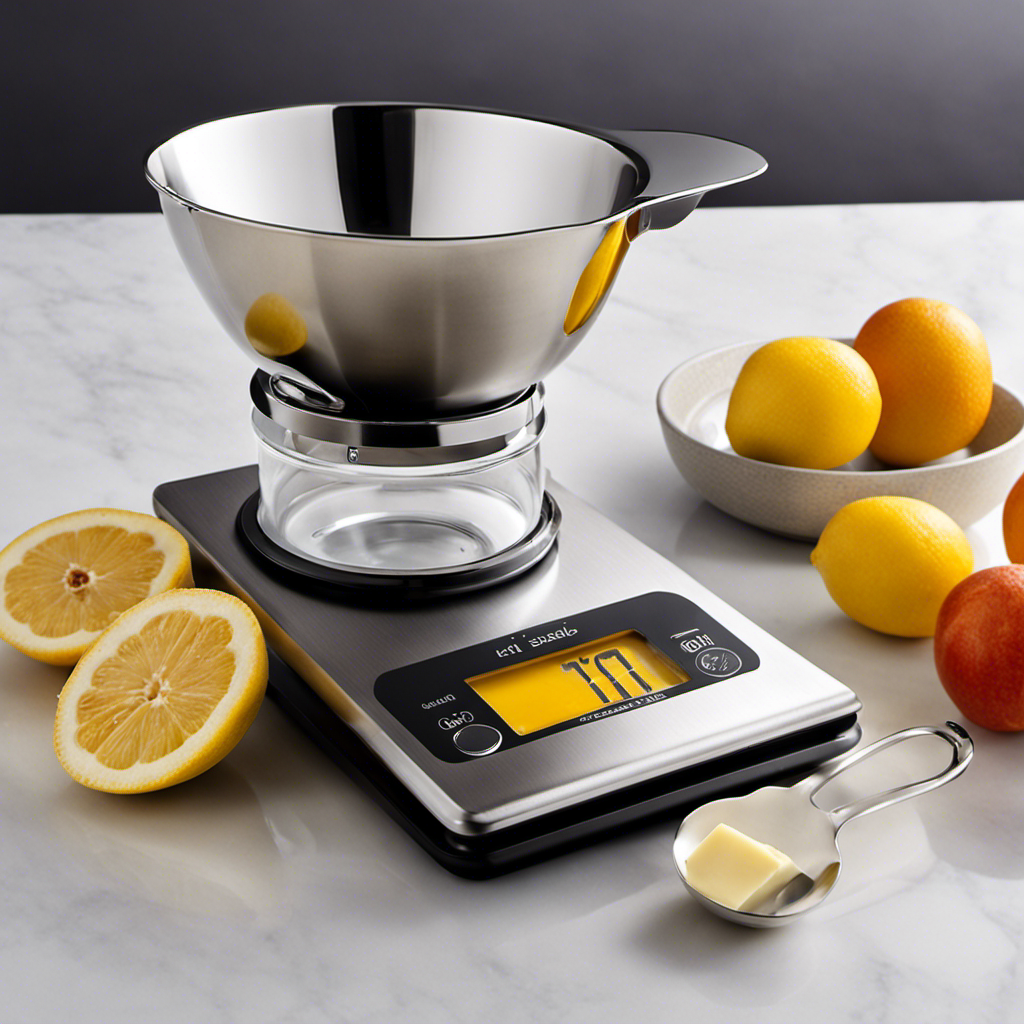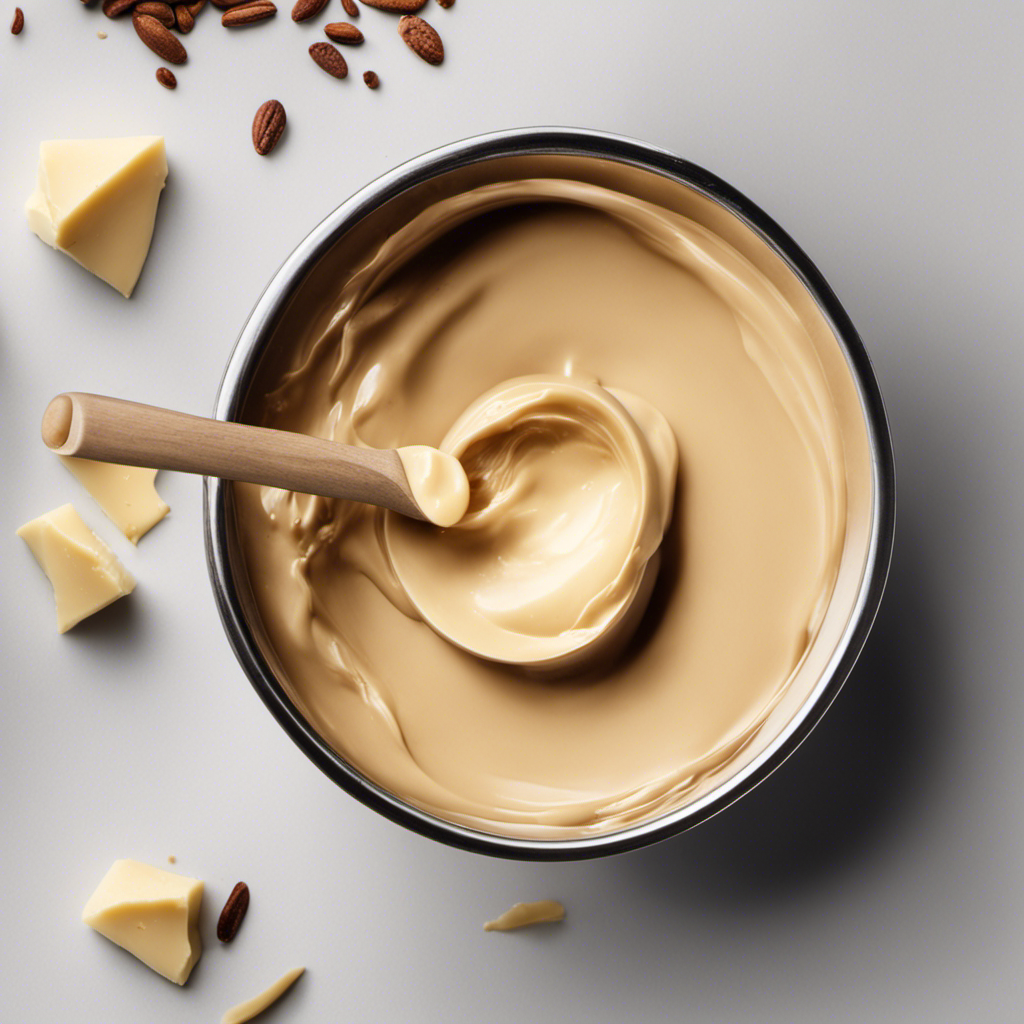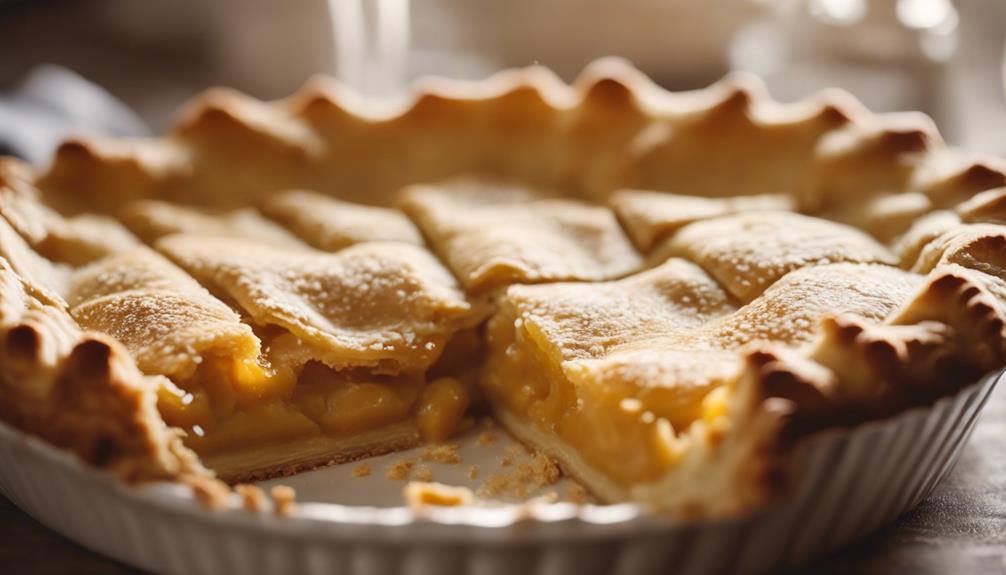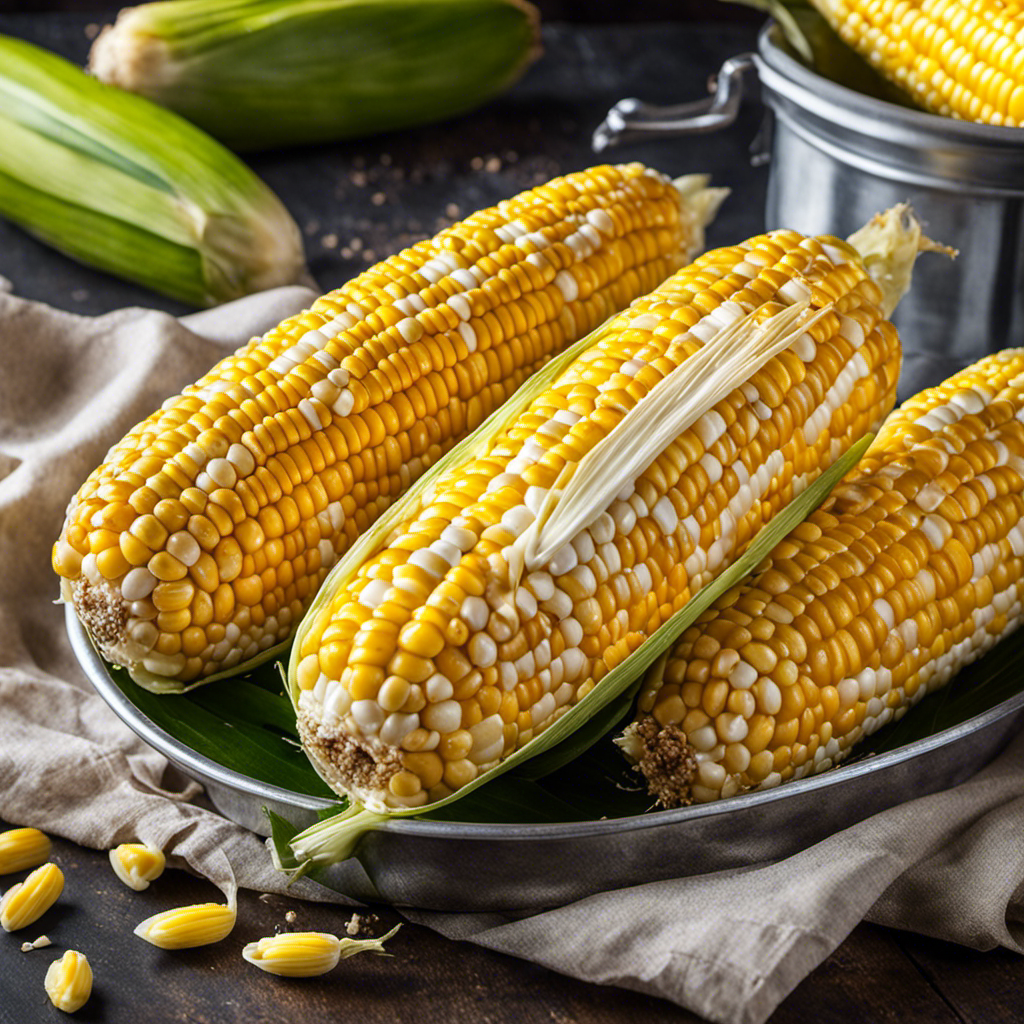I love trying out new ingredients in my recipes, and one that I’ve recently come across is cocoa butter. It not only gives a luxurious and smooth consistency to dishes, but also brings a delicious chocolatey taste.
But where can you buy cocoa butter for cooking? In this article, I’ll guide you through the best online retailers, local stores, and specialty shops that offer a wide range of cocoa butter options.
Get ready to elevate your culinary creations with this delicious ingredient!
Key Takeaways
- Online retailers like Now Foods, Life-Flo, iHerb, Nubian Heritage, and Dr. Woods offer a convenient option for purchasing cocoa butter for cooking.
- Local stores such as specialty food stores, gourmet markets, and health food stores are great places to find cocoa butter for cooking.
- Specialty shops that offer a wide variety of gourmet cocoa butter options provide superior quality and expertise.
- Buying cocoa butter online provides the convenience of delivery options and a wide range of choices, while local stores offer the opportunity to inspect the product and receive guidance from knowledgeable staff.
The Benefits of Using Cocoa Butter in Cooking
Using cocoa butter in your cooking can provide numerous benefits, such as enhancing the flavor and adding a creamy texture to your dishes.
When it comes to cocoa butter, there are different brands available in the market, each with its own unique flavor profile. Some brands may have a more intense chocolate flavor, while others may have a milder taste. It’s important to experiment with different brands to find the one that best suits your palate and the specific dish you’re preparing.
Cocoa butter also has a high melting point, which means it can withstand high temperatures without burning or losing its flavor. This makes it ideal for baking and sautéing, as it adds a rich, indulgent taste to your recipes.
Exploring Different Types of Cocoa Butter
When it comes to cocoa butter, there are a plethora of uses, health benefits, and culinary applications to explore.
As someone who has extensively researched the topic, I can confidently say that cocoa butter is not only a popular ingredient in skincare products, but it is also known for its moisturizing and healing properties.
Additionally, many culinary enthusiasts and chefs utilize cocoa butter in various recipes, from desserts to savory dishes, due to its unique flavor and ability to enhance the overall taste and texture of the food.
Cocoa Butter Uses
One popular use for cocoa butter is in homemade chocolate recipes. Cocoa butter, derived from cocoa beans, is known for its smooth and creamy texture, making it an essential ingredient in creating delectable chocolate treats. Not only does it add richness to the flavor, but it also helps in achieving that velvety melt-in-your-mouth consistency.
In addition to its culinary uses, cocoa butter is also highly valued in skincare products. Its moisturizing properties make it a popular choice for lotions, creams, and body butters. When applied topically, cocoa butter helps to lock in moisture, leaving the skin feeling soft and supple. It is also believed to have antioxidant properties that can help protect the skin from free radicals and promote a youthful appearance.
Here is a table showcasing some popular cocoa butter recipes and skincare products:
| Recipes | Skincare Products |
|---|---|
| Homemade Dark Chocolate | Cocoa Butter Body Lotion |
| Chocolate Truffles | Cocoa Butter Lip Balm |
| Chocolate Fudge Brownies | Cocoa Butter Massage Oil |
| Chocolate Ganache | Cocoa Butter Body Scrub |
| Chocolate Bark | Cocoa Butter Hand Cream |
Whether it’s indulging in delicious chocolate treats or pampering your skin, cocoa butter is a versatile ingredient that brings both joy and nourishment.
Health Benefits
To reap the health benefits of cocoa butter, you can incorporate it into your skincare routine or try incorporating it into homemade body products. Cocoa butter is derived from the cacao bean and is known for its moisturizing and nourishing properties. It is rich in antioxidants, which help fight free radicals and protect the skin from damage. Cocoa butter also contains fatty acids that can help improve skin elasticity and hydration.
Additionally, it has been found to have anti-inflammatory properties, which can help soothe and calm irritated skin. There are different types of cocoa butter available, including raw and refined. Raw cocoa butter is minimally processed and retains more of its natural nutrients, while refined cocoa butter undergoes further processing to remove impurities.
Incorporating cocoa butter into your skincare routine or homemade body products can provide numerous health benefits for your skin.
Culinary Applications
You can enhance your culinary creations by incorporating cocoa butter, which adds a rich and velvety texture to your dishes. Cocoa butter is a versatile ingredient that can be used in various culinary techniques and flavor pairings.
Here are some ideas to inspire you:
- Use cocoa butter to make smooth and creamy chocolate ganache for desserts like truffles or cakes.
- Incorporate cocoa butter into your homemade ice cream for a luscious and indulgent treat.
- Experiment with savory dishes by using cocoa butter in marinades or sauces to add a subtle chocolatey note.
Cocoa butter can be purchased at specialty food stores or online retailers that cater to culinary ingredients. Make sure to look for high-quality cocoa butter to achieve the best results in your cooking.
How to Choose the Best Cocoa Butter for Cooking
When it comes to choosing the best cocoa butter for cooking, two key factors to consider are quality versus price. It’s important to find a balance between a high-quality product and a reasonable price point.
Additionally, understanding the various uses and applications of cocoa butter can help in making an informed decision.
Quality Vs. Price
If you’re looking for cocoa butter for cooking, finding the right balance between quality and price can be a challenge. As someone who loves to cook and experiment with different ingredients, I understand the importance of sourcing high-quality cocoa butter without breaking the bank.
Here are a few tips to help you navigate the world of cocoa butter alternatives and find the best option for your needs:
-
Consider organic cocoa butter: Opting for organic cocoa butter ensures that you are getting a product that is free from pesticides and other harmful chemicals.
-
Look for fair trade certifications: Sourcing cocoa butter from fair trade suppliers helps support sustainable farming practices and ensures fair wages for farmers.
-
Read customer reviews: Before making a purchase, take the time to read customer reviews to get an idea of the quality and performance of the product.
Uses and Applications
Using cocoa butter in desserts adds a rich and creamy texture to your favorite treats. But did you know that cocoa butter has other amazing uses beyond the kitchen?
Cocoa butter is not only delicious but also beneficial for skincare. It is a natural moisturizer that can help nourish and hydrate the skin. When applied topically, cocoa butter forms a protective barrier that locks in moisture, leaving your skin feeling soft and smooth. Its rich texture makes it an ideal ingredient for moisturizers, lotions, and body butters.
The antioxidants present in cocoa butter also help fight free radicals and promote a youthful appearance. So, whether you’re baking a batch of brownies or looking to pamper your skin, cocoa butter is a versatile ingredient that can bring both pleasure and nourishment to your life.
Top Online Retailers for Cocoa Butter
You can easily find top online retailers for cocoa butter. These retailers offer a wide range of options, ensuring that you can find the perfect cocoa butter for your needs. Here are some of the best places to buy cocoa butter online:
-
Amazon: With its vast selection and competitive prices, Amazon is a go-to destination for cocoa butter. They offer top cocoa butter brands like Palmer’s and Navitas Naturals.
-
Vitacost: Known for its focus on natural and organic products, Vitacost offers high-quality cocoa butter from brands like Now Foods and Life-Flo.
-
iHerb: iHerb is a popular online retailer that carries a variety of cocoa butter brands, including Nubian Heritage and Dr. Woods.
When it comes to skincare, cocoa butter has numerous benefits for the skin. It is deeply moisturizing, helps improve elasticity, and can even help reduce the appearance of scars and stretch marks. So, whether you’re looking to cook with cocoa butter or use it for skincare, these top online retailers have you covered.
Local Stores That Carry Cocoa Butter for Cooking
When it comes to finding cocoa butter for cooking, local stores are a convenient option to explore. While online retailers offer a wide range of choices, sometimes it’s easier to find what you need right in your own neighborhood.
Local suppliers often carry cocoa butter, which is essential for many recipes and baking projects. Not only can you save on shipping costs, but you also have the advantage of speaking directly with knowledgeable staff who can provide guidance and recommendations.
Additionally, visiting local stores allows you to inspect the product before purchasing, ensuring its quality and freshness. To find cocoa butter locally, simply search for specialty food stores, gourmet markets, or health food stores in your area.
This way, you can enjoy the convenience and personal touch that local suppliers offer, without the hassle of finding cocoa butter online.
Specialty Shops for Gourmet Cocoa Butter
Specialty shops offer a wide selection of gourmet cocoa butter for all your baking needs. These shops are known for their high-quality products and expertise in the field of baking. Here are three reasons why specialty shops are the best place to buy gourmet cocoa butter:
-
Variety: Specialty shops have a wide range of gourmet cocoa butter options to choose from. Whether you’re looking for a specific brand or flavor, you’re sure to find it at these shops.
-
Quality: Gourmet cocoa butter is known for its superior quality. Specialty shops source their products from reputable suppliers, ensuring that you get the best cocoa butter for your baking.
-
Expertise: The staff at specialty shops are knowledgeable about cocoa butter and can provide you with valuable advice and recommendations. They can guide you in choosing the right cocoa butter for your specific baking needs.
Bulk Suppliers of Cocoa Butter for Cooking
For those looking to stock up on cocoa butter, bulk suppliers offer a convenient solution. Bulk suppliers specialize in providing large quantities of cocoa butter, making it easier for you to stock up and ensure you have enough for all your culinary creations.
When it comes to culinary uses, cocoa butter is a versatile ingredient that can enhance the flavor and texture of various dishes. From chocolate desserts to savory dishes, cocoa butter adds a rich and smooth mouthfeel to your recipes.
Whether you’re a professional chef or a home cook, having a reliable source of cocoa butter in bulk can save you time and money. So, if you’re in need of cocoa butter for your cooking endeavors, look no further than bulk suppliers for a hassle-free shopping experience.
Cocoa Butter Options for Different Dietary Needs
When it comes to cocoa butter, there are options available for different dietary needs. For those looking for cocoa butter substitutes or vegan alternatives, there are a few options to consider.
-
Shea butter: Derived from the nuts of the shea tree, this butter has a similar creamy texture and can be used as a substitute for cocoa butter in recipes.
-
Coconut oil: This versatile oil can be used as a vegan substitute for cocoa butter in certain recipes. It adds a subtle coconut flavor and has a smooth texture.
-
Avocado butter: Made from the flesh of avocados, this butter is a great vegan alternative to cocoa butter. It has a rich, creamy texture and is packed with nutrients.
These cocoa butter substitutes and vegan options provide a great alternative for those with dietary restrictions or preferences. They can be easily found in health food stores or online retailers specializing in vegan products.
Tips for Using Cocoa Butter in Your Favorite Recipes
To enhance the flavor and texture of your favorite recipes, try incorporating cocoa butter as a versatile ingredient that can elevate your dishes to the next level.
Not only does cocoa butter add a rich and creamy taste to your dishes, but it also offers several benefits for your skin. Cocoa butter is widely known for its moisturizing properties and can help hydrate and nourish your skin. Additionally, it contains antioxidants that can protect your skin from environmental damage and promote a youthful appearance.
If you’re looking to make homemade cocoa butter recipes, you can try incorporating it into baked goods like brownies or cookies for a decadent and indulgent treat. You can also melt it and drizzle it over fruits or use it as a base for homemade chocolates.
The possibilities are endless when it comes to using cocoa butter in your favorite recipes.
Frequently Asked Questions
Can I Use Cocoa Butter as a Substitute for Regular Butter or Oil in Baking?
Yes, cocoa butter can be used as a substitute for regular butter or oil in baking. It adds a rich, chocolate flavor and has the added benefit of being dairy-free and high in antioxidants.
Is Cocoa Butter Suitable for People With Dairy Allergies or Lactose Intolerance?
Cocoa butter is a suitable alternative for people with dairy allergies or lactose intolerance. It contains no dairy products or lactose, making it a safe option. You can find cocoa butter in specialty food stores or online.
Can Cocoa Butter Be Used for Savory Dishes or Is It Primarily Used in Sweet Recipes?
Cocoa butter can be used in savory dishes, adding a rich and velvety texture. While it is primarily known for its use in sweet recipes, it can be a unique and delicious substitute for regular butter in cooking.
How Long Does Cocoa Butter Last and How Should It Be Stored?
Cocoa butter lasts for about 2-5 years if stored properly. To tell if it’s gone bad, check for a rancid smell or change in texture. Store it in a cool, dry place away from heat and sunlight for best results.
Are There Any Potential Health Risks or Concerns Associated With Consuming Cocoa Butter in Cooking?
There are no known health risks associated with consuming cocoa butter in cooking. In fact, it has potential benefits such as being rich in antioxidants. However, it’s important to use it in moderation, as recommended dosage is key.
Conclusion
Well, who would have thought that cocoa butter could be such a versatile ingredient in the kitchen?
From its rich flavor to its smooth texture, cocoa butter adds a touch of luxury to any dish.
And the best part? You can easily find it online or at your local stores.
So go ahead, indulge in the irony of using cocoa butter to create delicious meals that will leave your taste buds wanting more.
Trust me, it’s a culinary secret worth exploring!

